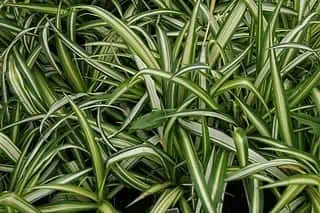In recent years, young adults have become quite fond of growing plants in their homes. The trend remained, and nowadays, the demand for houseplants in the market continues to increase.
Among the most sought-after indoor plants is the spider plant.
Here are 8 spider plant varieties you can choose from. The most popular spider plant varieties are the variegated spider plant, reverse spider plant, zebra spider plant, ocean spider plant, Hawaiian spider plant, bichetii spider plant, bonnie spider plant, and bracket spider plants.
If you’re thinking about which spider plant variety to get for your home, stick around and find out which option appeals most to your taste
Table of Contents
What Are Spider Plants?
Spider plants are considered one of the most quintessential indoor houseplants.
Not only do they survive inside your home, but they can also thrive even with the bare minimum of their growth requirements.
They are easy to care for and produce pulps or spiderettes that you can plant directly in another pot.
Where Did Spider Plants Originate?
Spider plants originally came from Africa. However, they are also native to some regions in Asia and Australia with tropical and subtropical climates.
Most pure spider plants only have a single color depicted by different shades of green. Eventually, horticulturists cross-bred several spider plant varieties producing variegated leaves with more than one color.
How Did the Spider Plant Get Its Name?
The name spider plant refers to the general form of the ornamental, which resembles a spider with legs stretching out of its body.
Specifically, the spiderettes, sometimes called babies or plantlets, grow out of the mother plant’s stem extending outwards the same way a spider stretches out its legs.
Variegated Vs. Non-variegated Spider Plants
Years of breeding produced different varieties of spider plants that can be identified either as variegated or non-variegated.
A variegated spider plant usually has a dual-colored pattern on its leaves.
For example, it can have a broad white or light-yellow pigmentation on the middle with forest green margins – or it could look the opposite in which the solid green color goes in the middle and the lighter hue along the edges.
Either way, the two colors usually come in parallel vertical stripes running down through the slender, elongated leaves.
On the other hand, non-variegated spider plants exhibit only one color instead of two. Usually, they appear to have forest green shade throughout the leaves.
Some people find nom-variegated spider plants too plain compared to their variegated counterparts.
However, more people have begun to recognize the unique beauty of pure non-variegated spider plants. The only downside is that they can be challenging to find in the market.
Top 8 Spider Plant Varieties
Choosing the spider plant for your home need not be complicated if you know your options.
But whichever variety you end up buying holds the same benefits as the others. So, your decision may simply depend on your aesthetic choice.
So, without further ado, let’s look closely into the top spider plant varieties you can grow indoors.
Variegated Spider Plant (Chlorophytum comosum Vittatum)

The variegated spider plant or Vittatum may be the most common variety, and it remains very popular. You can find lots of different spider plants here on Amazon
Vittatum is far from boring with its medium leaves laced with green stripes on edge and a broad white streak on the middle. In addition, it is highly tolerant of drought, so you don’t have to worry about its survival even if you leave for a few days.
Reverse Spider Plant (Chlorophytum comosum Variegatum)

With soft yellow margins and a strong green in the middle on its slender leaves, the Variegatum looks like a reversed version of the Vittatum variety.
Aside from the coloration, Variegatum leaves can extend longer than Vittatum, making it more common in gardens. Nonetheless, you can keep one indoors.
Zebra Spider Plant (Chlorophytum laxum)

The zebra spider plant looks like the Variegatum variety except for its lighter outline leaf patterns.
Likewise, this spider plant species grows wider instead of taller. So, you can easily grow it in a hanging basket instead of a nursery.
Ocean Spider Plant (Chlotophtum comosum Ocean)

The ocean spider plant is another Variegatum look-alike with its green center and cream margins. However, the ocean variety is spikier and has shorter leaves that cascade down the hanging pot.
Hawaiian Spider Plant (Chlorophytum viridescens Hawaiian)

If you’re looking for a spider plant with broader, greener, and more striated leaves, then you’d be fond of the Hawaiian spider plant.
One stunning feature of the Hawaiian species is its noticeable glossy overcoat, earning the name Golden Glow.
It’s also compact and can only grow for up to 2 feet, so it’s easy to manage,
Bichetii Grass (Chlorophytum bichetii)

The bichetii grass is a spider plant that is often compared to grass since it’s commonly found on ground soil. Plus, its slender green leaves with ivory white margins are almost grass-like.
Unlike other spider plants that you can place on hanging pots, this species grows better on a regular pot. This is due to their lack of spiderette off-shoots. Nevertheless, you can still have them indoors.
Bonnie or Curly Spider Plant (Chlorophytum comosum Bonnie)
The bonnie or curly spider plant looks like swirls of striated Vittatum variety. Although they share the same pattern as the regular variegated spider plant, the Bonnie leaves are more arched and narrower.
Bracket Plant (Chlorophytum capense)
The bracket plant is another spider plant species with missing spiderettes. Like the bichetii grass, the bracket plant green leaves have white edges. However, its flowers grow upward instead of hanging.
Benefits of Growing Spider Plants Indoors
Spider plants still remain one of the top choices among other houseplants for various reasons. Primarily, they provide plenty of benefits for your physical and psychological health.
Check out some of the benefits you can enjoy from having spider plants in your home.
They purify the air in the room.
Spider plants are established champions in air purification.
According to a reported study by NASA, houseplants, including spider plants, effectively remove air pollutants like formaldehyde, ammonia, and benzene. These substances can be toxic and have to be filtered out.
While you can get yourself an air-purifying machine, it’s still best to use natural air purifiers like spider plants.
Not only do they remove 95% of the pollutants, but they also supply oxygen which adds to the air quality improvement in the room.
They are aesthetically pleasing.

The unique pattern and spider-like form of spider plants make them ideal indoor decorations that easily impress your visitors.
With their arching leaves, homeowners usually place them on hanging baskets which enhance the greenery vibe in the room. Others opt to put the spider plants on their wall shelf or near the window.
Nonetheless, wherever you position the spider plant, they still provide a pleasing sight for everyone in the room.
They reduce stress levels.
Indoor plants, in general, provide comfort and soothing.
According to a 2015 study, working with plants around can lower your blood pressure and heart rate, making you feel less stressed.
Naturally, spider plants contribute to these advantages. That is why it’s easier to relax if you have spider plants inside the room.
Final Thoughts
With its long and gracious leaves, often appearing with two different but parallel colors, the spider plant does not simply provide aesthetics but also keeps your space safe from air pollution.
Therefore, whichever variety you choose is worth every penny given its benefits.
So, don’t hesitate to get yourself a spider plant. It could just be the very thing your room needs today.
Recent Posts
Have you found yourself wondering, 'why is my bamboo growing so slow?' Despite the fact that bamboo plants are remarkably fast-growing, it can sometimes take months (or even years!) to see any signs...
Miracle-Gro is a huge help when you are trying to get decent yields out of your plants or if you want them to thrive. However, you may have noticed that a single dose of fertilizer does little to...
